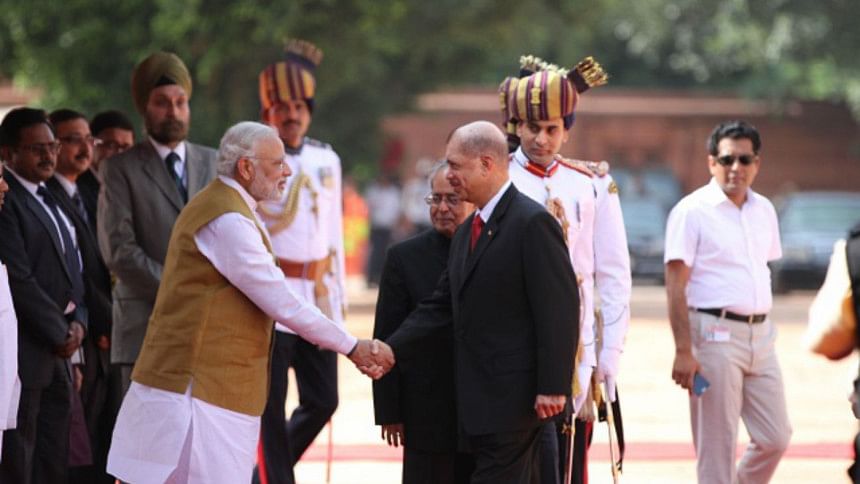Turbulent waters of Indian Ocean

In his last assignment as India's top diplomat, former Foreign Secretary S Jaishankar had paid a previously unannounced visit to the strategic Indian Ocean island of Seychelles late in January this year when the two countries signed a revised pact to develop military infrastructure on Assumption Island.
Assumption Island is located about 1700km from the mainland of East Africa where China set up a military base in Djibouti in July last year. The pact that caps years of hard diplomatic negotiations gives India a chance to further consolidate its presence in the Indian Ocean region where China has been expanding its reach. The Chinese base near the Bab-el-Mandeb Strait is reckoned as one of the busiest shipping lanes and one of three key Indian Ocean arteries connecting the Mediterranean Sea via the Suez Canal and the Red Sea to the Gulf of Aden and the Indian Ocean and beyond.
The revised agreement for the development of Assumption Island was necessitated to address domestic political concerns in Seychelles over the sovereignty and use of the facility that India will develop. It was during Indian Prime Minister Narendra Modi's visit to Seychelles in March 2015 that the two countries had first signed an agreement for development of facilities at Assumption Island. During the same tour, Modi had signed a similar agreement with Mauritius for Agalega Island. But the agreement with Seychelles had run into domestic political feud and was never implemented as it was not tabled in the National Assembly of the island nation for ratification despite the pact being signed during the term of President James Michel when the ruling party had the majority in the parliament.
There had been concerns among Seychelles' civil society and the opposition about the provisions of the agreement. In parliamentary elections in Seychelles in 2016, the ruling party in that country lost its majority in the National Assembly, which went to the opposition coalition, Linyon Demokratik Seselwa (LDS). Michel resigned and handed over power to his vice-president Danny Faure in October 2016. However, LDS leader, Indian-origin Wavel John Charles Ramkalawan, during his recent visit to India as part of the PIO Parliamentarian Conference in New Delhi last year, indicated that a political consensus had been reached. The signing of the revised agreement, after taking into account the concerns in certain quarters in Seychelles and incorporating a clause that India cannot use the military infrastructure in the event of a war, is, therefore, expected to be more solid.
India's naval presence is in sync with Modi's Indian Ocean doctrine envisaging "a climate of trust and transparency, respect for international maritime rules and norms by all countries, sensitivity to each other's interests, peaceful resolution of maritime issues and increase in maritime cooperation." This fits in Modi's pet project of 'SAGAR - Security and Growth for All in the Region' that aims at building stronger collaboration among countries straddling the Indian Ocean region which is central to India's strategic and economic interests. An estimated 95 percent of India's trade by volume and 70 percent by value come via the Indian Ocean.
Over the years, India and Seychelles have built an elaborate architecture of defence and security cooperation but it was during Modi's 2015 visit to the island nation that this cooperation made a landmark advancement. Seychelles' resource-rich Exclusive Economic Zone spread over 1.3 million square kilometres is particularly vulnerable to traditional and non-traditional security threats. Keeping this in mind, India and Seychelles have drawn up a cooperation agenda that covers joint efforts in anti-piracy operations, enhanced EEZ surveillance and monitoring to prevent intrusions by potential economic offenders indulging in illegal fishing, poaching, drug and human trafficking. As part of this, a coastal surveillance radar system was put into operation by India in Seychelles in March 2016 and India supplied three patrol ships and a Dornier aircraft to the country to secure its territorial waters.
The developmental dimension of cooperation among countries of the Indian Ocean region would remain inextricably tied to strategic interests of India and China and makes the region turbulent as the two countries seek to expand their spheres of influence there. China's setting up of the base in Djibouti, acquisition several months later of Hambantota port in Sri Lanka on lease for 99 years and reported efforts to develop several islands in Maldives, another Indian Ocean country long considered a close ally of India in South Asia, allow China quick military and economic access to India's sphere of influence. Both Sri Lanka and Maldives have signed on China's expansive One Belt, One Road initiative which India frowns upon.
All these developments have fed India's apprehensions about encirclement by China through what is famously called the 'String of Pearls' (bases) theory—making India drive hard to ramp up alliances with countries like Mauritius and Seychelles.
Pallab Bhattacharya is a special correspondent at The Daily Star.








Comments